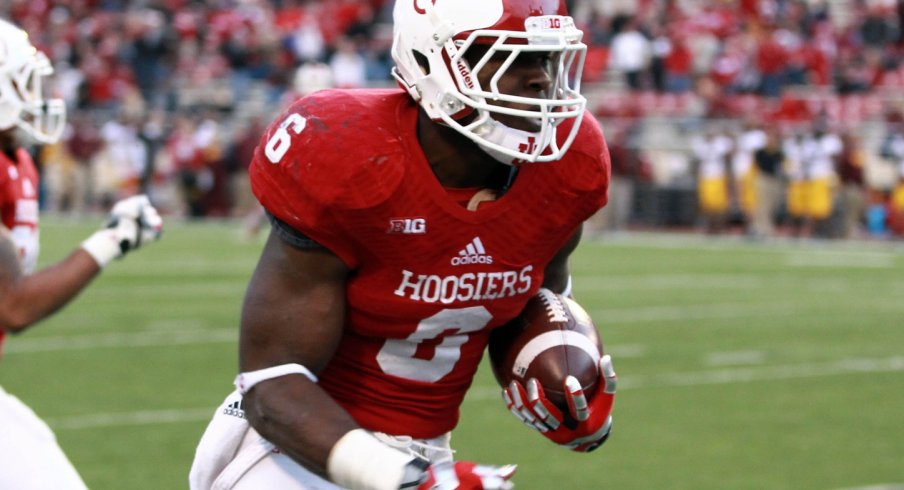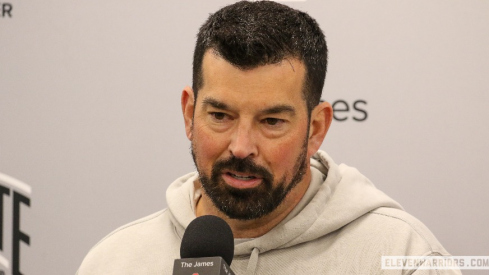Poor Tevin Coleman.
As the nation has finally opened its eyes to the amount of talent in the Big Ten, the star running back for the Indiana Hoosiers was still forgotten. Lost in the headlines of Melvin Gordon's record-setting afternoon in Madison, J.T. Barrett's weekly re-write of the Ohio State record books and the delights of enjoying a Dilly bar in sub-freezing temperatures was Coleman's effort; he tallied 307 rushing yards on the road in a 45-23 loss to Rutgers.
After shocking the college football world by beating the 18th-ranked Missouri Tigers on the road in early September, Indiana's season has turned south. The Hoosiers lost starting quarterback Nate Sudfeld for the season with a separated shoulder in mid-October. His backup, Chris Covington, tore his ACL in the same game.
In their place has stepped Zander Diamont, a true freshman from Venice, California. Though Diamont racked up gaudy numbers and countless awards at Venice High School, the son of a Soap star and occasional model has struggled to adjust to the Big Ten. Diamont has yet to make the same impact as his parents, completing only 46% of his passes in four losing efforts.
Coupled with the worst pass defense in the Big Ten, the Hoosiers' quarterback trouble is a recipe for disaster. Head coach Kevin Wilson appears to be headed for a winless season in conference play for the second time in his four years.
But as chaos ensues around him, Coleman shines. The junior from outside Chicago currently sits second in the nation in rushing yards behind Gordon, averaging a gaudy 7.84 yards-per-carry. His success has been no fluke.
The Hoosier running game is diverse and well-coached. After giving up 147 yards to Minnesota running back David Cobb a week ago, Ohio State defenders will have their hands full on Saturday as Coleman looks to make yet another statement to NFL scouts.
So how will the visiting Hoosiers look to attack the Buckeyes in their upcoming matchup?
Offense
IU head coach Kevin Wilson is most known for being one of the innovators of the spread offense, thanks to stints as coordinator of high-powered offenses at Northwestern and Oklahoma. But his philosophies center first and foremost around the position he played and spent the early part of his career coaching: the offensive line.
The Hoosiers feature an experienced group of maulers up front who are technically sound, using great leverage to move defenders and create lanes for Coleman. They have mastered the outside zone, or "stretch" play, which has led to a number of huge gains this fall.
At the snap, all five linemen take a lateral step in the direction the play is going, gaining ground horizontally before moving upfield at all. Coleman's aiming point is supposed to be the spot where the right tackle lines up, but in reality he's looking for a cutback lane to open before turning upfield.
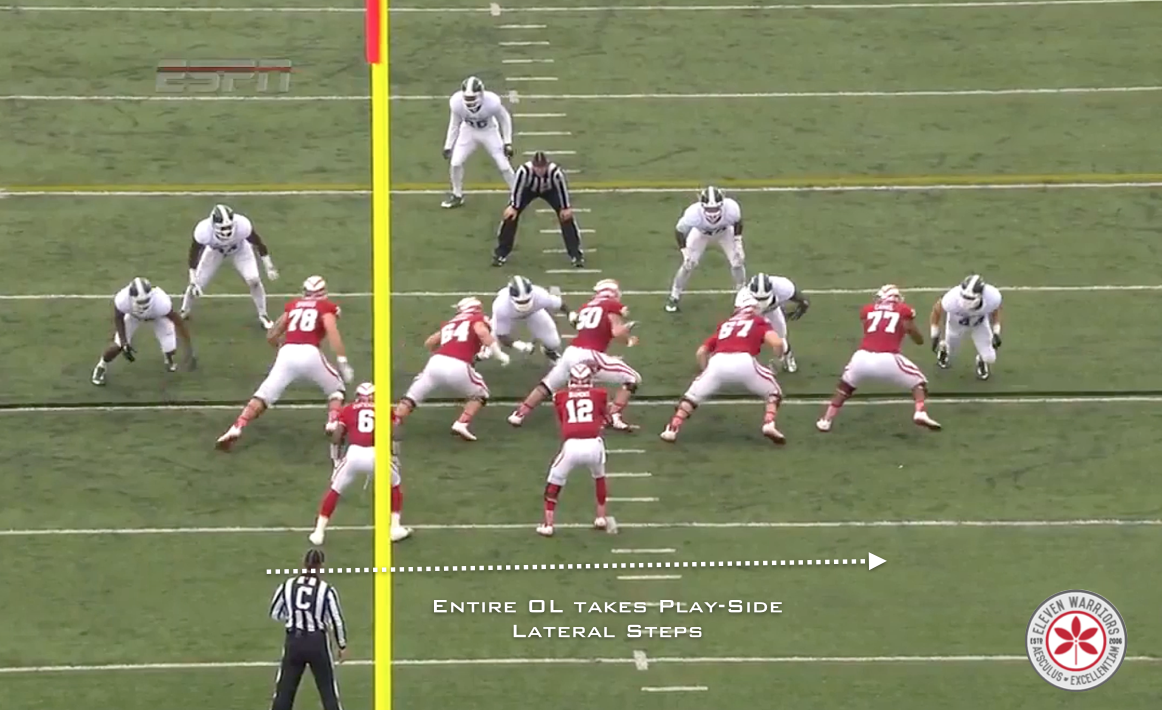
Knowing the defense will be coming straight upfield at first, the run-blockers are able to gain leverage by making contact with their opponents from the side, pushing them toward the sideline. One notable exception though is the interior lineman responsible for the defenders lined up in the "A" gap between the center and a guard, which in this case is left guard Collin Rahrig (#64).
As the opposing defensive tackle shoots the gap upon the snap, the left guard must also get a quick first step, staying low to maintain leverage and cutting him off from the backfield. After the guard has engaged with the tackle, he must keep moving his feet, working to "get his butt in the hole" as some coaches say, sliding his body between the defender and the sideline.
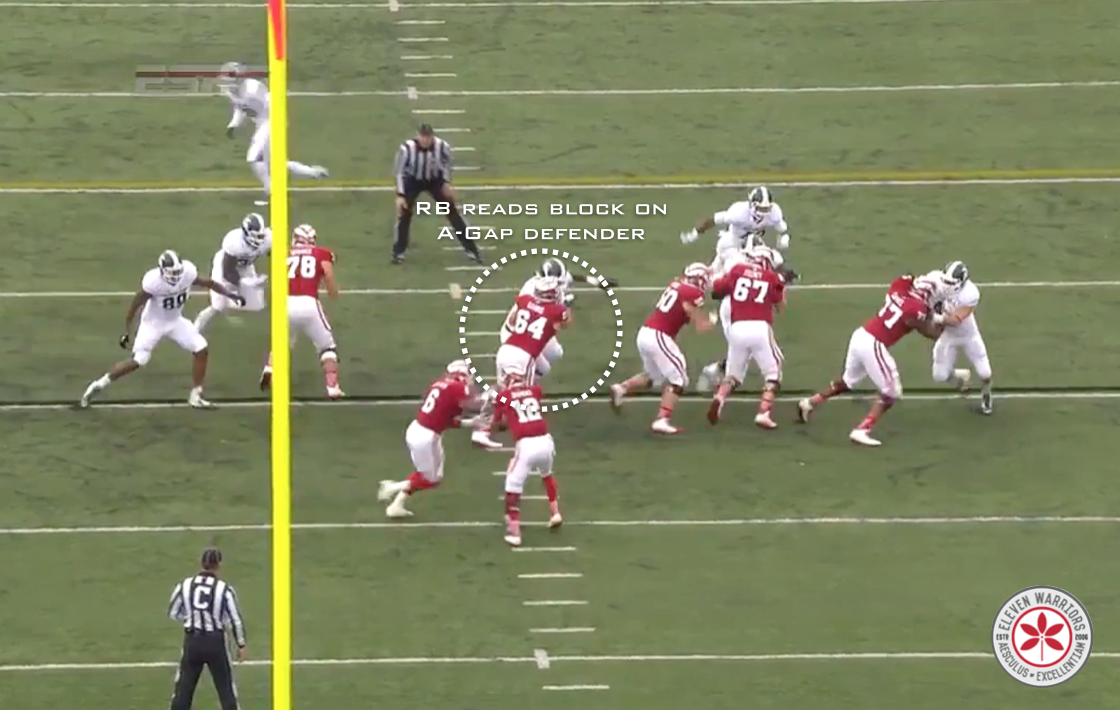
Meanwhile, the backside tackle has cut off the backside linebacker while the rest of the defense is moving toward the sideline. Once Rahrig gets his block around, Coleman is able to plant and turn upfield.
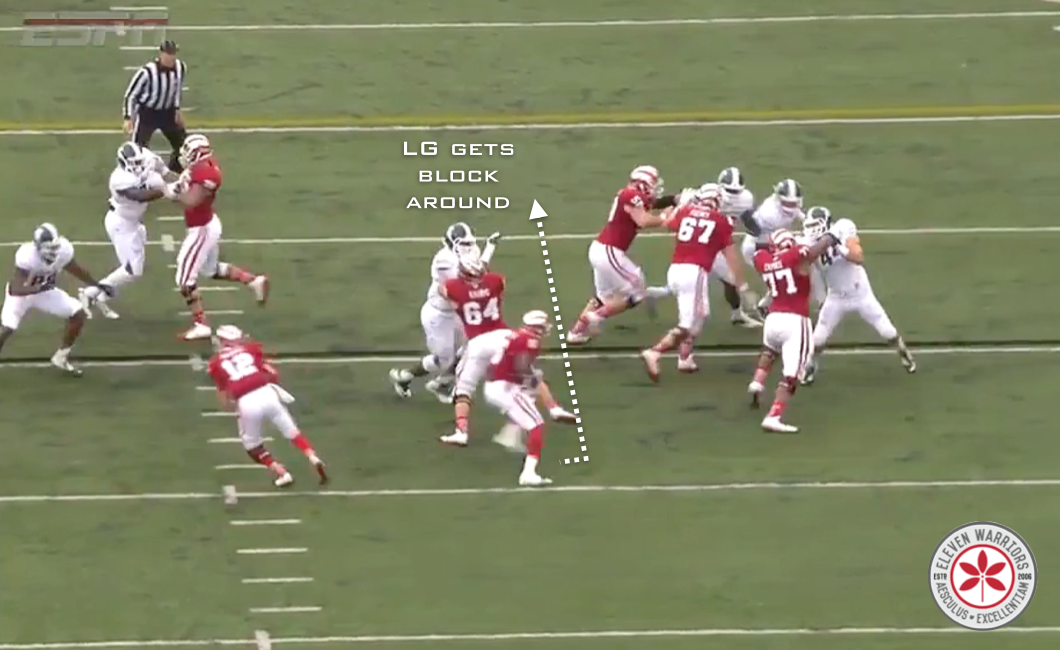
While Rahrig and the rest of the big guys up front have done a good job, Coleman shows the athleticism and quick burst that have NFL scouts taking serious notice.

The mix of the line's technical abilities along with Coleman's vision and explosion were on full display against Rutgers. The Hoosiers showed not only the tight (inside) and outside zones, but also executed one-back "Power" and the "Buck Sweep" to perfection.
Indiana has a major problem, though. Ever since Diamont took over under center, teams have been loading up the box to stop the Hoosier running game. As they did in their matchup with the Buckeyes, Penn State's defensive tackles did an excellent job of penetrating and causing Coleman to re-route his path in the backfield, holding him to a season-low of 71 rushing yards. Rutgers attempted the same tactic, but it lacked the bodies up front. It also took poor angles from the safety and linebacker spots, allowing Coleman to make one cut and go.
Just as it was in Minnesota, the onus is on Michael Bennett and Adolphus Washington to cause problems in the Hoosier backfield Saturday. The Buckeye linebackers must also do a better job of staying disciplined with their gaps and not over-running any plays. As Ross pointed out, Gophers running back David Cobb broke a couple big runs thanks to their over-pursuit; Coleman is fast enough that he needs only a small crease to gash the defense.
The Buckeye safeties should be there to help out in run defense, as the Hoosier passing game has yet to get on track since their freshman signal-caller took over. After 11 passing yards against Michigan State and attempting just eight passes the following week in Ann Arbor, Diamont finally connected on a few throws against Rutgers, although he completed less than half of his attempts yet again.
When Diamont does look to throw, he often looks first to side wide receiver Shane Wynn, who leads the team in catches with 43. The former Glenville Tarblooder made his name as a kick returner, and he is a threat to break any play for a touchdown. Wynn along with Coleman is often called on to catch screen passes, as Indiana looks to get its best athletes behind talented blockers in space.
To keep things simple for Diamont, he often is asked to make only one or two quick reads before looking to tuck the ball and run. He is a decent athlete and able to shake the first pass rusher, but he has yet to break any big runs. He often dances too much in the backfield, which has led to 12 sacks in four weeks.
Kevin Wilson has stated that Ohio State's defensive line may be the best in the country, so he knows his troops will have their hands full against Joey Bosa and company. But if the Hoosiers are able to run the ball effectively, that defensive line may get tired, much as they did against Minnesota in stretches.
The Hoosiers like to operate at a rapid no-huddle pace, even more so with Diamont than they did with Sudfeld. Keeping the Hoosiers from gaining yards on early downs will be crucial, as will not allowing IU to establish a quick pace and catch the OSU front on its heels.
Defense
Much like his offense, Wilson's defense is focused on winning the battle in the trenches. With a group of four big bodies that rotate on the interior of the defensive line, the Hoosiers look to create enough havoc at the line of scrimmage that their linebackers are left unblocked.
Operating with a true nose tackle in either Nate Hoff (#74) or Ralph Green III (#93) lined up directly over the center, the Hoosiers appear to play some 2-gap technique up front like a true 3-4 team. But unlike, say, the Pittsburgh Steelers, the Hoosiers have a hybrid linebacker/defensive end (called a "Bandit") that lines up to the weak side of the line, next to the defensive tackle. The other outside linebacker aligns in the slot like Buckeye SLB Darron Lee.
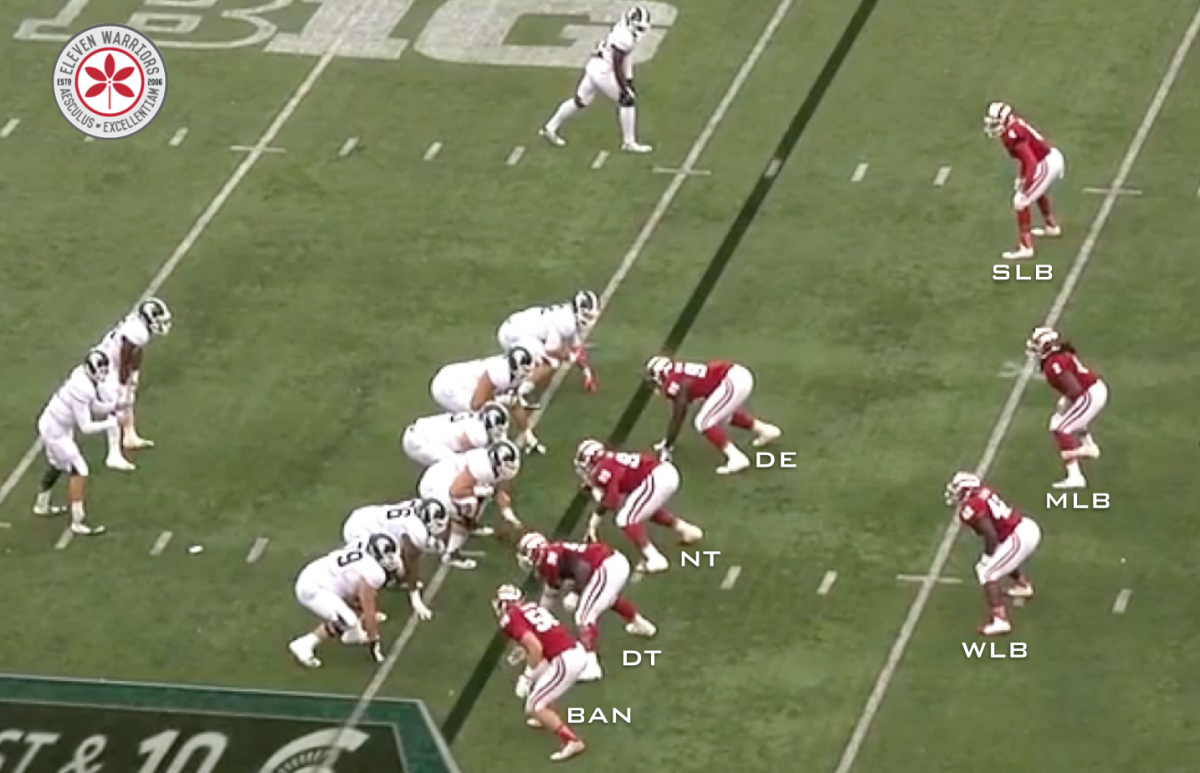
The defensive line is meant to act as a funnel for the inside linebacker tandem of T.J. Simmons (#2) and David Cooper (#42). While the interior tackles occupy the interior blockers, the defensive end and bandit set a strong edge, forcing runners to cut back inside toward the waiting arms of Simmons and Cooper.
Once a back makes that cut, the two are more than capable of making plays coming forward. Neither Simmons nor Cooper is especially tall, but they don't shy away from contact.
While the Hoosier front is good at stepping up to make tackles, it has struggled against runners with lateral quickness and tend to lunge when wrapping up, leading to countless broken tackles. Additionally, teams have been able to target the undersized Bandit, Nick Mangieri (#56) who is often giving up 50 lbs or more to opposing offensive tackles that can push him backward and creating huge running lanes to the outside.
Even though the defense is set up to let the inside linebackers make all the tackles, strong safety Antonio Allen (#40) actually leads the team in stops, as so many plays have made it to the second level.
To make things even worse for the Hoosier run defense, they've yet to face any true dual-threat quarterbacks this fall. Braxton Miller made it a habit of torching the Indiana run defense in the past, rushing for over 100 yards in three consecutive meetings, and there's no reason to think J.T. Barrett won't have similar success.

But Barrett should have plenty of opportunities to pad his Heisman resume this Saturday, as the Indiana pass defense has given up 300 yards on four separate occasions this season.
The Hoosiers primarily call the cover four zone that Ohio State has seen almost every week this season, meaning there isn't anything new from a schematic point of view. But with the IU safeties focused on helping in the running game, the cornerbacks have had to play way off their receivers, allowing their opponents to run crossing routes seemingly at will.
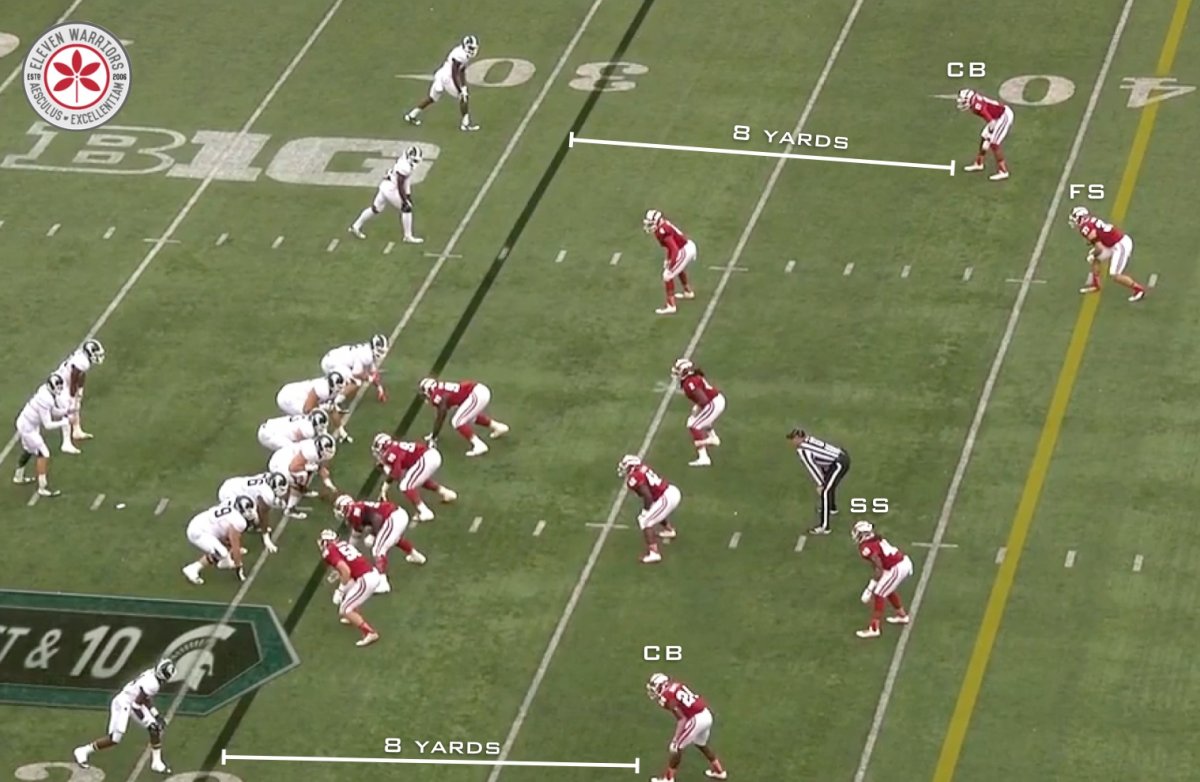
The corners do a great job of reading the quarterback and breaking on short, vertical-stemming routes like the hitches the Buckeyes used to pick apart Michigan State's cover four scheme. With so many defenders off the line, screens, jet sweeps, and other quick hitting plays that get the ball on the edges quickly can be expected.
But the Buckeyes will undoubtedly attack the Indiana safeties with play-action. After establishing the run, look for Devin Smith or Jalin Marshall to line up in the slot and try to make a play in the middle of the field.
Barrett and company should be able to take a number of shots downfield, as the Hoosiers lack much serious pass rush. Though (like everyone else), they were able to get pressure against Penn State's porous pass protection, the Indiana pass rush has only gotten to the opposing quarterback six times in four other conference games.
While Wilson has attempted to set up a scheme on both sides of that seems sound, injuries have left the Hoosiers as a shell of the team that pulled off that early season upset of Missouri. While many expected the Buckeyes to have a "trap game" in Minneapolis last week, Indiana poses a much higher threat of catching Ohio State looking ahead.
With a senior-day matchup against their biggest rivals a week away, followed by the Big Ten championship game one week later, the Buckeyes could be expected to have their attention elsewhere. Ohio State is more talented at nearly every position on the field, there's one spot where the Hoosiers have a talent edge, and it's the guy who will have the ball in his hands on nearly every play.
If the Buckeyes are able to contain Tevin Coleman, than the Vegas spread of 33 points will seem conservative. As Ohio State looks to rack up the ever-important "style points" to impress the playoff committee, keeping Coleman out of the end zone will be even more critical.
